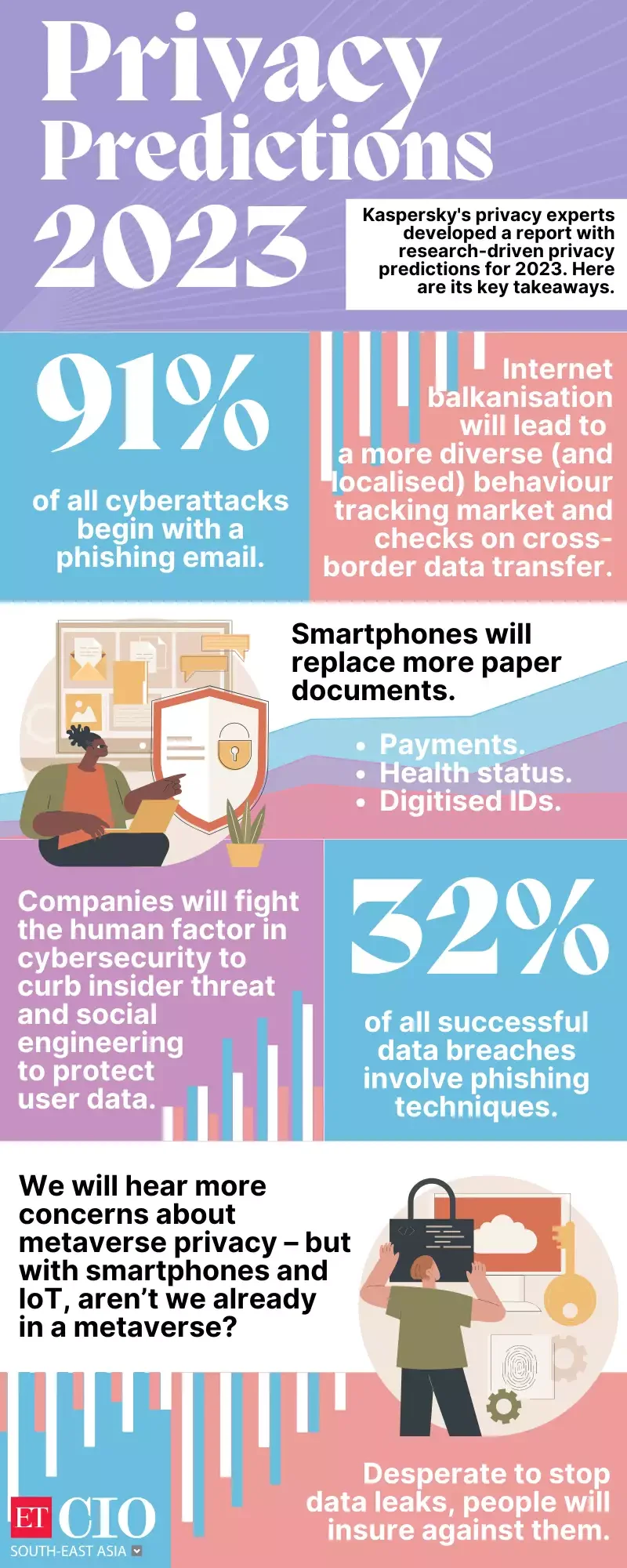
According to a report published by Kaspersky, internet balkanisation, metaverse, , and security insurance will be the main elements of privacy in 2023.
Let’s dive deeper into each of the elements mentioned in the Kaspersky report about privacy in 2023:
1. Internet Balkanization
“Internet balkanization” refers to the growing trend of the global internet becoming fragmented into isolated segments. This happens due to increasing regulatory and security measures by individual nations or regions.
Governments are tightening control over digital spaces, enforcing stricter data sovereignty laws, and sometimes limiting access to certain foreign content or platforms. The rise of geopolitical tensions and national security concerns has accelerated this trend.
For example, countries like China and Russia have already implemented highly restrictive policies to control internet access, create isolated versions of popular platforms (like China’s Great Firewall), and require data to be stored within their borders.
As more countries follow this model, we might see an internet that is no longer truly “global” but divided into separate zones, with restrictions on data flow between them. This could affect privacy in a number of ways:
- Data localization laws could mean that personal data is stored within certain countries, making it more difficult for international entities to access or secure that data.
- Access to information could be restricted, limiting the free flow of knowledge and communication across borders.
For individuals, this balkanized internet could lead to a more siloed experience, with less cross-border access to services, and potentially more risk of government surveillance or data misuse.
2. The Metaverse
The Metaverse—an interconnected virtual space where people interact through avatars and digital environments—has become a growing focus of privacy concerns. As this technology evolves, we are likely to spend more time in immersive, online environments for work, entertainment, and social interactions.
Some key privacy challenges associated with the Metaverse include:
- Personal data collection: Metaverse platforms could collect vast amounts of personal data, not only about user behavior but also biometric data like facial expressions, eye movements, and even emotions, depending on how immersive the platform is.
- Identity management: In virtual spaces, digital avatars or representations of users can blur the lines between online and offline identities. This raises questions about how well personal data is protected in these environments.
- Security risks: Just like other online platforms, Metaverse environments could be vulnerable to cyberattacks and data breaches that compromise personal information.
- Behavioral data: Companies operating in the Metaverse could track users’ movements, choices, and interactions, collecting detailed behavioral profiles that may be used for targeted advertising or sold to third parties.
Given the increasing time, people spend in virtual environments, ensuring privacy will be crucial to preventing exploitation and ensuring that users can enjoy the Metaverse without worrying about excessive surveillance or misuse of their data.
3. Security Insurance
As cyber threats continue to evolve, cybersecurity insurance will become a more prominent part of the conversation around privacy and data protection in 2023. Cybersecurity insurance is designed to help organizations manage the financial fallout of cyberattacks, data breaches, or other security incidents.
In recent years, there has been an explosion in the number of high-profile ransomware attacks, data breaches, and phishing scams that compromise personal and organizational data.
With the increasing complexity and frequency of cyber threats, insurance policies are evolving to cover the growing risks. Key aspects of cybersecurity insurance include:
- Coverage for data breaches: These policies may cover the costs of responding to data breaches, including notification of affected individuals, legal costs, and public relations efforts.
- Ransomware payments: Some cybersecurity insurance policies are now providing coverage for ransom payments in the event of a ransomware attack. This can be important for organizations that need to weigh the cost of a payment against the potential loss of business and data.
- Incident response: Many policies also cover the costs of an incident response team to investigate and manage the fallout from a cyberattack.
- Business continuity: In the event of a cyberattack or data breach, insurance can help businesses stay afloat by covering financial losses during downtime.
For individuals, security insurance might also play a role in protecting personal data, especially if the data is at risk due to third-party breaches or other issues. As the cost of cyber incidents continues to rise, businesses and consumers alike will likely turn to these insurance solutions to manage the financial impact and ensure that they are adequately covered in case of a breach.
4. Smartphone will replace Paper
smartphones will increasingly replace paper-based processes, making digital records the norm. While this transition offers greater efficiency, it also raises significant privacy concerns. As smartphones store more personal data, including sensitive information, they become prime targets for cyberattacks.
Paper documents, often physical and easier to secure, will be replaced by digital records stored on smartphones or cloud services. While this transition offers efficiency and convenience, it also introduces privacy risks:
- Data Collection and Storage: As smartphones become the central hub for our personal and professional activities, the amount of data they collect will continue to grow. This includes everything from location tracking and browsing history to biometric information. The more we rely on our smartphones, the more vulnerable our data becomes to potential breaches and unauthorized access.
- Access and Encryption: With the transition from paper to digital, ensuring robust data encryption becomes crucial. Sensitive documents or communications stored on smartphones must be well-protected to prevent unauthorized access or leaks.
- Security Risks: The more devices we connect to the internet and use for personal tasks, the greater the risk of hacking. Smartphones could become primary targets for cybercriminals trying to access private information. This makes it more important than ever to use secure apps, implement multi-factor authentication, and follow best practices for smartphone security.
Ensuring robust data encryption, secure access, and proactive security measures will be essential to safeguard personal information. Overall, as smartphones take center stage in our digital lives, protecting privacy will require careful management of data and security practices.
5. Human Factor
One of the biggest challenges companies will face in cybersecurity is addressing the human factor—the vulnerabilities that arise from human behavior. Despite advancements in technology, human error remains one of the most significant threats to data security. Companies will take several measures to combat this issue and protect user data:
- Enhanced Training and Awareness Programs: Organizations will continue to invest in cybersecurity training for employees, teaching them to recognize phishing attacks, use strong passwords, and adhere to best practices for data protection. Regular training and simulations will be key to reducing mistakes and increasing vigilance.
- Zero Trust Security Models: Companies will adopt Zero Trust frameworks, where access to systems and data is granted based on strict identity verification, regardless of whether users are inside or outside the corporate network. This reduces the risk of internal threats or accidental exposure by treating every user and device as potentially compromised.
- Passwordless Authentication: The move toward passwordless authentication systems, like biometric verification or authentication apps, will reduce the reliance on passwords, which are prone to human error and theft. This can significantly enhance security and minimize the chances of breaches caused by weak or reused passwords.
- Stronger Insider Threat Detection: Companies will also focus on identifying and mitigating risks from insider threats, both malicious and accidental. Monitoring tools that track access to sensitive data can help detect unusual activity from employees, minimizing the impact of potential errors or malicious actions.
- Improved Incident Response Plans: Companies will refine their incident response plans, ensuring they are prepared for the inevitable breaches that might occur due to human error. Quick, well-coordinated responses can minimize the damage and reduce the long-term effects of a security breach.
In summary, to tackle the human factor in cybersecurity, companies will focus on a combination of education, technology, and detection tools. While human behavior will remain a critical vulnerability, these strategies will help organizations better protect user data and reduce the likelihood of security incidents.
Conclusion
This forecast was developed based on the shifts and trends observed by Kaspersky’s privacy experts in 2022. Throughout the year, experts tracked significant developments in cybersecurity, privacy concerns, and technological advancements that shaped the digital landscape. These observations helped identify the key challenges and strategies that will impact privacy in 2023.


![Understanding the role of AI in Cyber Security [Infographic] hero-image-State-of-AI-Cybersecurity-2024](https://www.skillzme.com/wp-content/uploads/2024/11/hero-image-State-of-AI-Cybersecurity-2024-200x200.jpg)
![2024 Global AI Report [Infographic] hero-image-Q1-2024-AI-and-ML-Report](https://www.skillzme.com/wp-content/uploads/2024/11/hero-image-Q1-2024-AI-and-ML-Report-200x200.jpg)
![Dubai Tourism Statistics 2024 [Infographics] hero-image-inforgaphic-Dubai-Tourism-2024](https://www.skillzme.com/wp-content/uploads/2024/11/hero-image-inforgaphic-Dubai-Tourism-2024-200x200.jpg)


Recent Comments